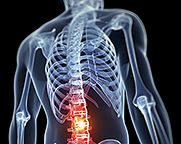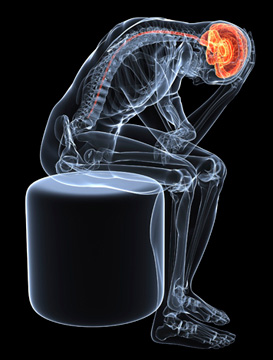Stress is a part of life, and so is back pain. Ironically, stress is a
leading cause of episodic back pain.
Your body experiences a cascade of
physiological responses during chronic stress setting the stage for
injury. The human body is genetically programmed to respond to stressful
situations by stimulation in a survival part of your brain known as the
limbic system. Otherwise known as the reptilian or primal brain, it is
responsible for the emotional "flight or fight" (run or stand and fight)
response to negative stimuli.
Your brain response functions the same in
stressful situations regardless of the source and extent of the
threatening stimuli. The limbic brain does not recognize differences
between types and degrees of stress. It simply reacts. Your body
releases hormones (chemical messengers) which cause a physical reaction
to stress; shortness of breath, sweating, increased heart rate, muscle
tension, tightness or stiffness in joints, etc., in preparation for
survival reaction.
So whether you are about to be chased by a rabid dog,
cut off in traffic, or had a tough day at work the same response
occurs. The same negative physical impact also occurs on the body.
There are several different types of stress and learning how to control
them can make all the difference. You have physical stress (lack of
exercise, illness, sleep habits, etc), mental stress (how you deal
emotionally with life) and chemical stress (nutritional and
environmental).

Stress alters breathing patterns by causing you to breathe more from the
chest/lungs than the diaphragm. This altered pattern increases tension
in the neck and upper back leading to poor posture, muscle tightness and
headaches. The diaphragm is a dome shaped muscle that sits in the lower
part of the ribcage underneath the lungs. Optimal breathing patterns
should occur from the diaphragm first, followed by the lungs. Most often
people have dysfunctional patterns where this sequence is reversed.
Breathing is the foundation for relaxation. Learn to control your
breathing and you will have discovered a secret weapon of relaxation and
stress reduction. To check your breathing pattern lie on your back with
knees bent. Close your eyes and place one hand on your abdomen and the
other on your chest. Take a deep breath in through your nose. The lower
hand should move first and the upper hand second. If the upper hand
moves first you have an altered breathing pattern. Luckily it is fairly
easy to learn how to breathe again properly. In our quick tip help
guide below you will learn how to restore normal breathing patterns.
Stress increases tension in the body 24/7. It is like flipping the
light switch on for self- protection, muscle tension and tightness.
Think about how stiff and tight you feel when walking across ice. Your
body tenses up in anticipation of falling and is trying to protect you
from injury. Imagine how your muscles would feel if you were in this
constant state of tension for weeks at a time. It would not feel good!
That is what chronic stress is doing.
Stress increases production of
specific hormones known as cortisol and adrenaline located in the
adrenal glands. These are two small glands that rest on top of the
kidneys, one on either side. Cortisol is nicknamed the "stress hormone"
and it can cause many negative reactions in the body if it is
unbalanced. Chronically elevated levels of cortisol and adrenaline will
cause increased inflammation in the body. In essence, your own body
begins to turn on itself.
So what are some simple and effective tips you can start doing today
to help alleviate stress? Below are suggestions for helping physical,
mental and environmental stress in your life.
Nutrition: Eat healthy and eat often to control
blood sugar levels. When you wait long periods between meals, you have a
spike of a hormone known as insulin. This hormone controls how fast
sugar enters your bloodstream after eating. Big surges in insulin occur
when you wait too long between meals which may increase stress on your
body chemistry. You can get cravings and mood swings. Eating only three
meals a day is insufficient in keeping this delicate balance of hormones
in check. It is recommended to eat three meals a day, mixed in with 2-3
healthy snacks. You will notice a renewed sense of energy and vitality
with regular feedings.
Mental: Take some "me" time every morning before you
start the day. Use this time to reflect on yesterday and plan out
today's events. With the craziness of non-stop information overload in
today's society it's more important than ever to take quiet moments. Set
your alarm 15-minutes early and wake up to silence. Do not turn on the
television or open the newspaper. You may find that problems which have
plagued you suddenly become more manageable and put into perspective.
When was the last time you sat in a room without white noise all around?
Try it and see what happens.
Physical: Learning how to breathe with your
diaphragm takes some practice, but in time it will become second nature.
Practice the following technique on a daily basis for 3-5minutes. Lie
on your back, putting a pillow support under your knees to relax your
lower back. Place one hand on your abdomen and the other on your chest.
Slowly inhale through your nose and make sure the only hand to move is
the one on your abdomen. Try to keep the hand on your chest as still as
possible. Exhale through pursed lips and repeat. You may become
temporarily lightheaded after your first few, but this is a normal
response to the increase in oxygen uptake by the body. Do this before
bed time and you will have a more restful sleep leading increased
recovery and regeneration.
You do have power over your body. Simple changes in your life to help
reduce stress can have a profound impact on your health. Take back
control of your life from pain. Empower yourself to feel good again
mentally and physically. Start with the simple strategies above and when
you feel the positive difference you will want more for yourself.
To decrease the stress in your life, talk to your chiropractor about your concerns.
 According to a 2008 study published in BMC Musculoskeletal Disorders,
a connection exists between physical inactivity and chronic
musculoskeletal complaints (MSCs). Study participants responded to
questions regarding their physical activity 11 years prior to
experiencing any MSCs.
According to a 2008 study published in BMC Musculoskeletal Disorders,
a connection exists between physical inactivity and chronic
musculoskeletal complaints (MSCs). Study participants responded to
questions regarding their physical activity 11 years prior to
experiencing any MSCs.




